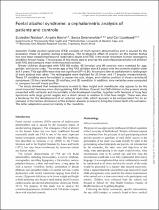| dc.description.abstract | Foetal alcohol syndrome (FAS) consists of multi-system abnormalities and is caused by the
excessive intake of alcohol during pregnancy. The teratogenic effect of alcohol on the human foetus
has now been established beyond reasonable doubt and FAS is the most important human teratogenic
condition known today. The purpose of this study was to analyse the craniofacial parameters of children
with FAS and compare them with matched controls.
Ninety children diagnosed with FAS (45 males, 45 females) and 90 controls were matched for age,
gender, and social class. The mean age of the FAS children was 8.9 years with the controls slightly older
at 9.1 years. This age difference was not signifi cant ( P = 0.34). A standard lateral cephalometric radiograph
of each subject was taken. The radiographs were digitized for 20 linear and 17 angular measurements.
These 37 variables were formulated to assess the size, shape, and relative position of three craniofacial
complexes: (1) the cranial base, (2) midface, and (3) mandible. In addition, nine variables were computed
to compare the soft tissue profi les.
The study showed that measurements related to face height and mandibular size appear to be the
most important features when distinguishing FAS children. Overall, the FAS children in the present study
presented with vertically and horizontally underdeveloped maxillae, together with features of long face
syndrome with large gonial angles and a short ramus in relation to total face height. There was also
a tendency for the development of an anterior open bite, which appears to be compensated for by an
increase in the vertical dimension of the anterior alveolar process to bring the incisor teeth into occlusion.
The latter adaptation occurred mainly in the mandible. | en_US |

